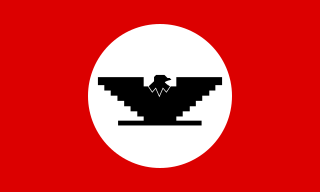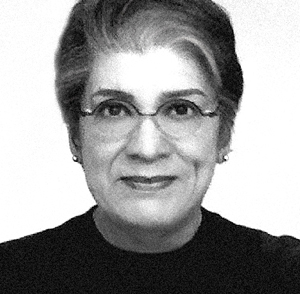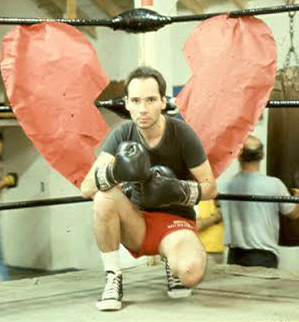
Chicano or Chicana is an ethnic identity for Mexican Americans that emerged from the Chicano Movement. Chicano was originally a classist and racist slur used toward low-income Mexicans that was reclaimed in the 1940s among youth who belonged to the Pachuco and Pachuca subculture.

Estrada Courts is a low-income housing project in the Boyle Heights area of Los Angeles, California. It is located on E. Olympic Blvd & S. Lorena st.
Harry Gamboa Jr. is an American Chicano essayist, photographer, director, and performance artist. He was a founding member of the influential Chicano performance art collective ASCO.

Gronk, born Glugio Nicandro, is a Chicano painter, printmaker, and performance artist. His work is collected by museums around the country including the Smithsonian American Art Museum.

Los Four was a Chicano artist collective active based in Los Angeles, California. The group was instrumental in bringing the Chicano art movement to the attention of the mainstream art world.
Elsa Flores is a well known Chicana street artist. Her mother's name was Maria Valenzuela and she was originally from a small village called San Javier located in Sinaloa, Mexico. She is one of the best known members of the Chicano street art movement.

Self Help Graphics & Art, Inc. is a community arts center in East Los Angeles, California, United States. Established in 1970, Self Help Graphics served as a critical locus of activity during the Chicano art movement and remains a significant center for Chicanx and Latinx artistic production. SHG is most well-known for organizing annual Day of the Dead festivities, in addition to hosting exhibitions and musical performances. Throughout its history, the organization has worked with well-known artists in the Los Angeles area such as Barbara Carrasco, Los Four, the East Los Streetscapers, and Shizu Saldamando.

The Williams College Museum of Art (WCMA) is a college-affiliated art museum in Williamstown, Massachusetts. It is located on the Williams College campus, close to the Massachusetts Museum of Contemporary Art and the Clark Art Institute. Its growing collection encompasses more than 14,000 works, with particular strengths in contemporary art, photography, prints, and Indian painting. The museum is free and open to the public.
Diane Gamboa has been producing, exhibiting and curating visual art in Southern California since the 1980s. She has also been involved art education, ranging from after-school programs to college and university teaching. Gamboa has been "one of the most active cultural producers in the Chicana art movement in Los Angeles." She actively developed the Chicano School of Painting.

Judithe Hernández is an American artist and educator, she is known as a muralist, pastel artist, and painter. She is a pioneer of the Chicano art movement and a former member of the art collective Los Four. She is based in Los Angeles, California and previously lived in Chicago.

The Chicano Art Movement represents groundbreaking movements by Mexican-American artists to establish a unique artistic identity in the United States. Much of the art and the artists creating Chicano Art were heavily influenced by Chicano Movement which began in the 1960s.
Patssi Valdez is an American Chicana artist. She is a founding member of the art collective Asco. Valdez's work represents some of the finest Chicana avant-garde expressionism which includes but not limited to painting, sculpture and fashion design. She lives and works in Los Angeles, California.
Willie F. Herrón III is an American Chicano muralist, performance artist and commercial artist. Herrón was also one of the founding members of ASCO, the East Los Angeles based Chicano artists collective .

Jerry Dreva (1945–1997) was an artist, writer, performer, activist, and teacher from South Milwaukee, Wisconsin. He was a principal proponent of Mail art. His efforts were concentrated in the areas of self-documentation and performance, often employing subterfuge and a wry sense of humor. He was a founding member of the conceptual rock band Les Petites Bon-Bons.

Chicano Art: Resistance and Affirmation was a traveling exhibit of Chicano/a artists which toured the United States from 1990 through 1993. CARA visited ten major cities and featured over 128 individual works by about 180 different Chicano/a artists. The show was also intended to visit Madrid and Mexico City. CARA was the first time a Chicano exhibit received major attention from the press and it was the first exhibit that collaborated between Chicanos and major museums in the U.S. The show was considered a "notable event in the development of Chicano art." Another unique feature of CARA was the "extensive planning" that attempted to be as inclusive as possible and which took place more than five years prior to the opening at Wight Art Gallery.

Les Petites Bon-Bons was a group of conceptual/life artists that originated in Milwaukee, Wisconsin, in the early 1970s. Their activities spanned the nascent gay activist movement, the international correspondence network and the Hollywood glitter rock scene. They are known largely by the work of Jerry Dreva and Robert Lambert, aka Jerry and Bobby Bonbon, and who achieved much of their fame by effectively manipulating major media outlets.

Chicana art emerged as part of the Chicano Movement in the 1960s. It used art to express political and social resistance through different art mediums. Chicana artists explore and interrogate traditional Mexican-American values and embody feminist themes through different mediums such as murals, painting, and photography. The momentum created from the Chicano Movement spurred a Chicano Renaissance among Chicanas and Chicanos. Artists voiced their concerns about oppression and empowerment in all areas of race, gender, class, and sexuality. Chicana feminist artists and Anglo-feminist took a different approach in the way they collaborated and made their work during the 1970s. Chicana feminist artists utilized artistic collaborations and collectives that included men, while Anglo-feminist artists generally utilized women-only participants. Art has been used as a cultural reclamation process for Chicana and Chicano artists allowing them to be proud of their roots by combining art styles to illustrate their multi-cultured lives.
Rita Gonzalez is an American curator, author and media artist. She is the head of the contemporary art department at Los Angeles County Museum of Art (LACMA), an institution she has worked at since 2004. Many of her curatorial projects involve under-recognized Latinx and Latin American artists.
Edmundo Meza, also known as Mundo Meza, was an artist and activist who was born in Tijuana, Mexico and grew up in East Los Angeles. He discovered his passion for the area's avant-garde culture in early 1970. As an emerging artist, Mundo Meza worked for shoe designer Fred Slatten on Santa Monica Boulevard as a window dresser. He also painted unique designs onto Slatten's platform shoes, gathering a celebrity clientele which included Cher, Elton John, and Diana Ross.
The queer Chicano art scene emerged from Los Angeles during the late 1960s and early 1990s composing of queer Mexican American artists. The scene’s activity included motives and themes relating to political activism, social justice, and identity. The movement was influenced by the respective movements of gay liberation, Chicano civil rights, and women’s liberation. The social and political conditions impacting Chicano communities as well as queer people, including the HIV/AIDS epidemic, are conveyed in the scene’s expressive work.












